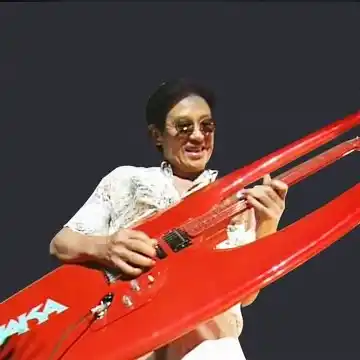
Masayoshi Takanaka is a Japanese fusion guitarist. He is famous for his signature playing style, spectacular performances, and extraordinary guitars. One of the most famous is the Surfboard Guitar.
But before we talk about it, let’s meet the guitarist himself if you haven’t already. This man deserves attention no less than his famous instrument.
Table of Contents
Who is Masayoshi Takanaka?
Masayoshi Takanaka was born in Tokyo in 1953.
In 1971, Tsunoda Hiro and Shigeru Naruke invited him to join the rock band “Fried Egg” as a bassist. This marked the beginning of his career as a professional musician.
In 1972, he joined the band “Sadistic Mika Band” as a lead guitarist.
In 1975 the band broke up, but Takanaka continued to work as part of the later-formed band “The Sadistics.”
In 1976, he made his solo debut with the “Seychelles” album. In his following solo albums, he released numerous hits such as “Ready To Fly” and “Blue Lagoon.” His most famous work is “Rainbow Legend,” released in 1981.
He has performed live with international musicians such as Lee Ritenour, Santana, Narada, Michael Walden, and others.
He worked for Kitty Records and Toshiba EMI before founding his own label, “Lagoon Records,” in 2000. Since then he has toured the country every year.
Masayoshi Takanaka’s music is characterized by its smooth, upbeat, and feel-good vibes. His tracks are lively and highly melodic, often featuring catchy guitar solos.
Why Was The Surf Guitar Made?
Anyone who sees this instrument for the first time has a reasonable question: “Why?”
In fact, if you heard Takanaka’s music, you’ve already know the answer. What stands out in Takanaka’s music is its uplifting and positive character. It’s the kind of music that can instantly brighten your mood. In addition, Takanaka lived in the Bahamas for a long time. And this had a significant influence on his music, giving it a laid-back tropical vibe.
This is how Masayoshi Takanaka himself describes the story of creation:
“It’s a strange story… When Shigeru Naruke passed away, I thought about it a little. “You can do what you like while you’re alive. When you’re dead, you can’t do anything”…So I decided to make a surfboard guitar. I’m jumping the gun a bit, but I was thinking, “Oh, come to think of it, surfing was popular around the time of the Bubble Era… I have a summer song that goes well with it…” and then I thought it would be interesting to make a surfing guitar. I heard it was hard to make.”
Who Created The Surfboard Guitar?
This guitar was custom-made by Japanese luthier Takeda Yutaka in 2003. He was working for the Ram Trick Company at the time.
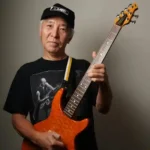
Master Takeda Yutaka said on his blog that he was a big fan of Takanaka’s music in his youth, often listening to Sadistics and early solo albums and even copying some of his songs.
In 2002, he met Takanaka and began collaborating with him on repairing his guitars.
“My first job was repairing the famous sunburst Stratocaster that appears in his second solo album.”
Takanaka once told him: “I want to use a surfboard-shaped guitar at the event.”
Takeda Yutaka was a little embarrassed by this request but agreed. Here’s what he said about it:
“I was a little happy to make Takanaka’s guitar, but a surfboard-shaped guitar… I had mixed feelings, but after detailed discussions and careful consideration, I decided to modify a real surfboard and install a guitar.”
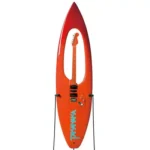
So they took a real surfboard, hollowed out a hole in it, and put a guitar in there. According to Takanaka, the neck and pickups are from Yamaha.
Here’s what Takeda Yutaka said about the process of creating this masterpiece:
“I still thought it couldn’t be a toy, so I made it with realism in mind.”
“The surfboard itself is hollow inside, so you can’t attach the neck or parts directly to it. So I attached the neck to a small wooden body and screwed it in from the back of the surfboard.”
“In order not to sacrifice playability, we made sure it wasn’t too heavy and left enough clearance around the neck.”
“Considering maintenance, the guitar part is removable.”“And we managed to deliver it to the studio where they were rehearsing just before the event. Of course, we didn’t compromise on the guitar part and did a job that we couldn’t be ashamed of.”
The guitar was originally light blue but was later repainted red. On some videos, you can see the original color, on others it’s red. Well, now you know that these are the same guitar.
Takanaka played this guitar in light blue during his 2004 and 2005 live tours. Bu-Speed of Love “Live 2004” and Crossover Japan “Live 2005” ft. Issei Noro.
During his performance at “Live 2008,” he already plays a red guitar.
The process of making the guitar was kept secret. This was meant to be a surprise for the show’s viewers. But in the end, shortly before the show, information about the guitar was leaked to the press. Nevertheless, the instrument caused everyone’s surprise and delight both during the first performance and in the following ones.
How To Play Surfboard Guitar?
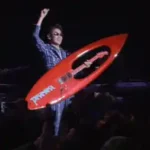
Takanaka used the surfboard guitar many times during his performances. In one TV interview, he conveyed about this instrument:
“It’s hard to play, as expected. I just play this because I wonder if the people who watch me will like it, but I wonder if some percentage of them think I’m stupid. It weighs about 6 kilograms (~13 lb), so if I play two songs on this guitar at a concert, I’ll be even more tired.”
In another interview, Takanaka confessed:
“I could manage for about two songs. But if I was asked to do it for two hours, I’d die.”
He also added that it was so difficult to make this guitar that the master told him: “I’m not doing it again.”
Besides The Surfboard Guitar
If you’ve already read our about Masayoshi Takanaka, you know that he is known for other incredible instruments.
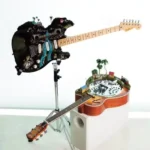
For example, the resonator “train guitar.” The body of this guitar features a diorama, a functional miniature model of a railroad. A train that runs while you play.
Then Takanaka decided to make the same with a Stratocaster. The base for the guitar was a Fender Stratocaster. Mountains are built on Strat’s body, on both sides of which there are tunnels, between which a train runs.
These guitars were made by Akihiro Morohoshi, a Japanese artist who creates miniature model railways by integrating them into everyday objects.
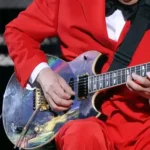
In 1981, during a live performance at the Nippon Budokan, Masayoshi Takanaka amazed the audience not only with his playing but also with a rainbow Yamaha SG 1000 guitar.
The “Rainbow Legend” guitar was made in 1979. It became one of the musician’s most famous guitars. But there were other painted guitars, such as the Yamaha SG-T2 “White Goblin.”
So, thanks to Masayoshi Takanaka for his talent and boundless, albeit slightly crazy, imagination! Now there is also a surfboard guitar in our universe. Well that’s cool…
